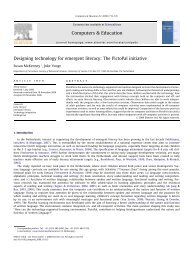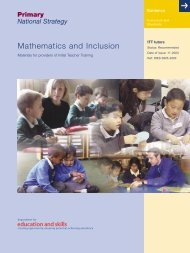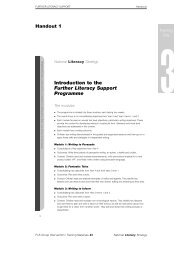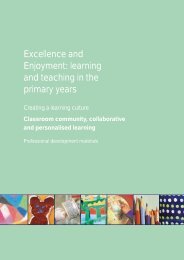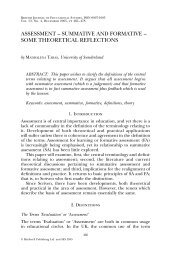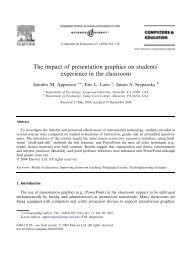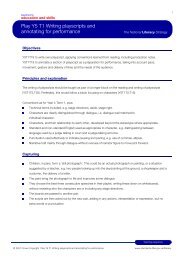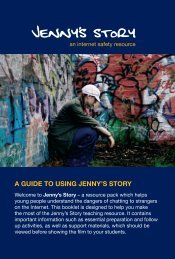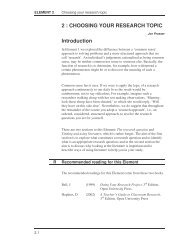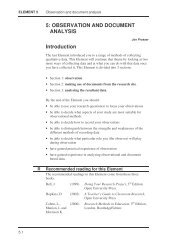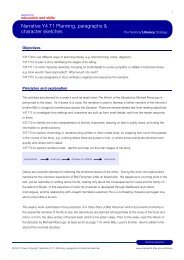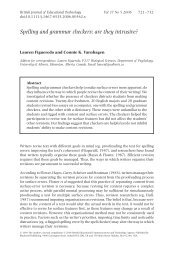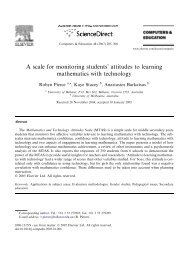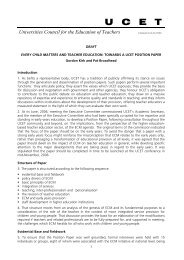Download - PGCE
Download - PGCE
Download - PGCE
- No tags were found...
Create successful ePaper yourself
Turn your PDF publications into a flip-book with our unique Google optimized e-Paper software.
Some of the publications referred to in this book are available by quoting thefull title or DfES reference number to: DfES publications Tel: 0845 60 222 60Email: dfes@prolog.uk.com
Primary National StrategyPublications and materials forcontinuing professional developmentIntroductionSince its launch in 1998, the National Literacy Strategy has produced many publicationsto support professional development in the teaching of literacy. This guide is intendedto help those involved in Initial Teacher Training (ITT) and Continuing ProfessionalDevelopment (CPD) to locate specific items within National Literacy Strategy materialsquickly and easily. Section 1* lists those publications produced to date that have beendistributed to NLS consultants and to colleagues in ITT. Section 2 comprises detailed,timed listings of the contents of video material associated with the publications. Section 3cross-references the materials to particular themes and aspects of literacy. A list of webbasedresources is included in Section 4 of the guide.Every effort has been made to check the accuracy of the details included in the guide.If, however, you do notice any errors please do not hesitate to contact us so that theycan be corrected.Thanks to Jo Barkham, from the University of the West of England, for her contributionto this document.*A number of publications listed in the guide are now out of print and will not be re-issued.Others were sent to tutors and consultants as soon as they became available. It is notanticipated that further copies will be sent out. The guide may be useful as a checklistwhen assembling materials into a resource area. Some publications may be rediscoveredin this process!
Primary National StrategyICT in the literacy hour: whole-class teachingThis CD-ROM provides guidance on how ICT canbecome a core component of the literacy hour bysupporting whole-class teaching.Ref. DfES 0620/2001ContentsVideo clips and commentaries for each term from Reception to Year 6● Shared reading – Reception● Word-level work – Year 1● Shared writing – Year 2● Shared reading – Year 3● Shared writing – Year 4● Sentence-level work – Year 5● Shared reading and writing – Year 6Teaching notes and materialsImplications for other year groupsBackground informationAdvice on hardware and software considerationsICT in the literacy hour: independent work and guided readingThis CD-ROM provides a flexible training resource,complementing the earlier materials ICT in the literacyhour: whole-class teaching. Together these twoCD-ROMs show how ICT can, when appropriate, beintegrated into the whole literacy hour.Ref. DfES 0015/2003ContentsVideo clips showing ICT use with children of various ages in a wide range of primaryschool settings.● Independent work– Supported writing– E-mail as a writing outcome– Multimedia presentations– Reading interactive texts– Researching/sourcing information– Creating a character database● Guided reading– Year 2 – an electronic dictionary– Year 4 – an electronic newspaper11 Publications and materials for continuing professional development © Crown copyright 2003
Primary National StrategyContentsTeaching and learning strategies● Training file– Directing discussion– Engaging all pupils– Investigations● Video clips– Teaching and learning strategies at Key Stage 1 and Key Stage 2– Guided writing● Fliers 1–6 (Ref. NLS 506)– Talking in class– Engaging all pupils– Looking at patterns– Writing in the literacy hour– Writing to inform– Telling talesManagement of literacy● Training file– Taking bearings– Action planning– Supporting change– The self-improving schoolWriting● Training file– Writing in the literacy hour– Writing non-fiction– Narrative writingIntervention programmes: ALS, ELS, FLSThe following three intervention programmes are designed for children who, withadditional support, can work at age-related expectations within the Framework forteaching. Their use is dependent on the assessment of progress against key objectivesfor literacy. The programmes are intended for delivery by teaching assistants and classteachers working closely in partnership.Additional Literacy Support programme (ALS)The Additional Literacy Support materials werepublished at the start of the Strategy to support pupilsin Year 3 (and, if necessary, Year 4) who needed toconsolidate key literacy skills and understanding earlyin Key Stage 2. The four eight-week modules focus onkey objectives for phonics, reading and writing.Books: Ref. NLS 1E – NLS 1HVideo: Ref. NLS 3Contents● Getting started: preparation for the teaching programme. This booklet providestraining materials for those preparing to implement ALS.● Module 1– Phonics and spelling13 Publications and materials for continuing professional development © Crown copyright 2003
Primary National StrategyELS top-up sessionsThese sessions are designed to provide extra support for children who have beenincluded in the ELS programme and assessed through the ELS ‘Exit Strategy’ (see ELS(three-day training), page 186) and require some additional support to consolidate skillsand understanding.ELS materials to support teachers working in partnership with teaching assistants● Introduction● Summary of objectives● Intervention sessions, weeks 1–12● Screening pack contents● GlossaryFurther Literacy Support programme (FLS)The Further Literacy Support programme is designedto support pupils in Year 5 who have achieved at leastlevel 2 at the end of Year 4 and who are working atlevel 3 in Year 5. It consists of a training programme,screening procedures and three modules of additionalliteracy sessions focused on key objectives fromYears 4 and 5.Training materials: Ref. DfES 0346/2002Video: Ref. DfES 0360/2002Resource pack: Ref. DfES 0359/2002Teacher’s book: Ref. DfES 0584/2002ContentsFLS training file● Background notes● Introduction to FLS● Planning – using targets and objectives● Shared writing● Guided reading● The role of the teaching assistant● Action planningVideo● Introduction to the programme● Focus on the plenary● Limbering up● Intervention lesson delivered by teaching assistant● Guided reading in Year 5FLS resource pack● Modules 1–3● Pupils’ books, cards, posters, homework activitiesFLS teacher’s book● CD-ROM● Materials to support the class teacher and teaching assistant15 Publications and materials for continuing professional development © Crown copyright 2003
Primary National StrategyLiteracy coordinator’s handbookThis handbook is designed to provide support for thoseleading and coordinating literacy and mathematicsacross the school. It is designed as a workingdocument and contains national materials, LEAguidance and additional papers which coordinatorsmay choose to add. The handbook can supplementexisting materials, and materials from it can beincorporated into other school documentation.Ref. DfES 0284/2002Contents● A self-evaluation grid● A coordinator planner● Training materials (literacy modules only)– Establishing priorities, analysing results and reviewing progress– Revisiting the plenary– Planning for progression– Creating an effective learning environment– Managing the deployment of additional adults– Planning for effective professional development● Supporting information● CD-ROM – a list of NLS publications● Video: teaching the plenary part of the lessonProgression in phonics: materials for whole-class teachingThese materials outline progression in teaching andlearning phonics in seven steps which are linked tothe objectives in the NLS Framework for teaching.Activities for whole-class teaching are suggested foreach step and instructions and materials for theseactivities are provided.Spiral-bound book and video: Ref: DfES 0126/2001Booklet and CD-ROM: Ref. DfES 0604/2001ContentsBooklet● Rationale for the teaching of phonics● Seven-step progression in teaching and learning phonics● Phonic activities for each step● Instructions and bank of materials for activitiesThe spiral-bound book has the same contents as the booklet together with photocopymasters to support the activities.CD-ROM● Interactive training activities to support the development of teachers’ knowledgeand understanding of progression in phonics● Resources including photocopy mastersVideo: activities with Foundation and Key Stage 1 pupils16 Publications and materials for continuing professional development © Crown copyright 2003
Primary National StrategyShared writing on school placementThis file contains materials to promote the use of sharedwriting during school placements. Shared writing ispresented as an integral part of the curriculum,informing children’s writing in all subject areas.Ref. ITT 01SContents● Planning for shared writing● Materials to support the planning of non-fiction shared writing sequences● Notes to support teachers’ and trainees’ discussions of the planning and teachingof shared writingSpelling bankThis was written for teachers at Key Stage 2 andcontains lists of words and activities to support thespelling objectives from the Framework for teachingfrom Year 3 to Year 6. The material includes examplesof whole-class approaches, group work and extensionactivities for each activity. It also contains notesconfirming spelling rules.Ref. DfEE 0086/2001Contents● Objectives from Year 3 to Year 6● Appendix 1 – Spelling around the clock● Appendix 2 – Teaching spelling conventions● Appendix 3 – Examples of investigations● Appendix 4 – Differentiation issues● Appendix 5 – Whole-class consolidation activities● Appendix 6 – Spelling journalSupporting pupils learning English as an additional language(revised 2002)This file is a revised version of the guidance originallypublished in 1999. The materials are located within theprinciples of inclusion set out in the National Curriculum2000 and developed from the guidance included insection 4 of the Framework for teaching.Ref. DfES 0239/200217 Publications and materials for continuing professional development © Crown copyright 2003
Primary National StrategySupporting the target-setting process: guidance for effective targetsettingfor pupils with special educational needs (revised 2001)The document is intended to support schools in thesetting of effective targets for pupils with specialeducational needs. It builds on earlier guidancepublished as an outcome of the DfEE/QCA project inwhich the National Foundation for Educational Researchwas commissioned to develop performance criteria, inconsultation with a large number of special andmainstream schools, for attainment below NationalCurriculum level 3 in English and mathematics.Ref. DfEE 0065/2001Teaching assistantsTeaching assistant file: induction training for teaching assistantsRef. DfEE 0131/2000Literacy module: induction training for teaching assistantsRef. DfEE 0130/2000Literacy Reception module: induction training for teaching assistantsRef. DfEE 0132/2000These training modules are designed to support the work of teaching assistants in theclassroom. The two modules are very similar in content.ContentsFile● Introduction● The role of the teaching assistant in the literacy hour● NLS resources (Literacy module)/The Early Learning Goals (Reception)● Early phonics● Review of activities● Later phonics● Reading in the literacy hour● Writing in the literacy hourVideo● Extracts of children working in Reception in the literacy hour and daily mathematicslesson are all included in the Literacy module video.19 Publications and materials for continuing professional development © Crown copyright 2003
Primary National StrategyWorking with teaching assistants: a good practice guideThis guide is intended primarily for headteachers,deputy heads and other teachers responsible for thework of teaching assistants.Ref. DfEE 0148/2000Contents● The role of the teaching assistant● Supporting the role of the teaching assistant● Carrying out an audit of current practiceTeaching writing: support material for text-level objectivesTen fliers which focus on strategies to improve writing.Ref. DfES 0532/2001Contents● Flier 1 – Improving writing● Flier 2 – Narrative● Flier 3 – Poetry● Flier 4 – Playscripts● Flier 5 – Recount: It happened like this...● Flier 6 – Instructions: Here’s one I made earlier...● Flier 7 – Non-chronological report: Telling it like it is... or was...● Flier 8 – Explanation: Cause and effect...● Flier 9 – Persuasion: Stating your case...● Flier 10 – Discussion: Points of view20 Publications and materials for continuing professional development © Crown copyright 2003
Primary National StrategyTowards the National Curriculum for EnglishThis document should be used alongside theCurriculum guidance for the Foundation Stage, theNational Literacy Strategy primary Framework forteaching and the QCA guidance Planning, teaching andassessing the curriculum for pupils with learningdifficulties. It provides examples of what pupils shouldknow, understand and be able to do at P levels 1 to 8.The examples are linked to both the Early LearningGoals and the NLS Reception objectives.Ref. DfES 0517/2002Year 6 literacy booster lessons 2003The booster lessons included in this book are designedfor those children who need targeted support to secureNational Curriculum level 4 in the Key Stage 2 Englishtests. They are not intended as a revision programmefor all Year 6 children. As the children work through the18 booster lessons, they will revisit key objectives thatwill help to ensure that they achieve their full potentialin the end-of-Key Stage 2 tests.Ref. DfES 0052/2003Year 6 More-able children materialsThis material is designed to support colleagues inrecognising the characteristics of more-able childrenand in providing an appropriate level of challenge forthem in English and mathematics.The four sessions included in the booklet make upa professional development day for Year 6 teachers.Ref. DfES 0752/2002Contents● Session 1 – Introduction and setting the context● Session 2 – The more-able child and mathematics● Session 3 – The more-able child and literacy● Session 4 – Key messages and next steps21 Publications and materials for continuing professional development © Crown copyright 2003
Primary National StrategyYear 6 planning exemplification 2002–2003Ref. DfES 0752/2002This booklet and CD-ROM contain examples of unitsof work for Year 6. The seven units are drawn from allthree terms in Year 6. Some of the units were writtenfor the Year 6 planning exemplification 2001–2002(also available) and are reproduced in this publicationwith some supplementary resources and/or guidance.Other units are new. They exemplify rich, varied andchallenging teaching to support pupils towardachieving levels 4 and 5 at the end of Year 6.ContentsBooklet● Introduction● Unit summaries● Target statements for reading● Target statements for writing● Plans– Poetry– Narrative reading– Narrative writing– Report writing– Argument– Formal writing– Explanation writing– Narrative reading revision– Narrative writing revision– Poetry reading revision– Non-narrative reading revision– Non-narrative writing revisionCD-ROM● Booklet● Narrative reading unit● Narrative writing unit● Argument unit● Report unit● Formal explanation unit● Poetry unit● Revision unitEach file includes resources to support the teacher in delivering the unit.22 Publications and materials for continuing professional development © Crown copyright 2003
Primary National StrategySection 2Video materialThis section provides a detailed listing of the contents of the videos referred to in Section 1.The listings note the main teaching focus, year group, and timing on each video. Each clipis given a title. The titles vary according to the vocabulary used on the materials. Wheneverthe word ‘clip’ is used it refers to the contents in the left-hand column of the video listing.All timings are approximate. Although every effort has been made to ensure they are asaccurate as possible, times may vary according to equipment used.NLS literacy training pack video 1This video has a running counter which does not coincide with ‘real time’ counters.Timings (approx) are in minutes and seconds from start of tape, plus tape count if given.Clip Focus Year group Start time Duration Tapeapprox approx count(min:sec) (min:sec)Module 1 Introduction 0:50 2:10 000David BlunkettSequence 1 Commentary giving Y6 3:00 1:10 013Shared text an overview ofworkshared reading.ColletteSome interviewswith teachersMarie Shared reading Y1 4:10 1:25 019Joan Shared reading: Reception 5:35 2:52 028The jigareeAnnie Shared writing: Y4 8:27 2:27 045demonstrationof redraftingPeter Planning a story Y6 10:54 1:24 060John Stannard Principles of shared 12:18 1:48 069reading/writingSequence 2 ‘Humpty Dumpty’. Reception 14:00 1:09 079Word/sentence Alternative version,level work children puttingGordonin rhymeRachel Robot words. Reception 15:09 1:19 089Blending phonemesto read words23 Publications and materials for continuing professional development © Crown copyright 2003
Primary National StrategyClip Focus Year group Start time Duration Tapeapprox approx count(min:sec) (min:sec)Pie Word and sentence Y3 16:28 1:05 093level workSequence 3 Routines of 17:33 0:57 100Guidedindependent workingreading/writing shown firstJean Matthew’s tantrum. Y2 18:30 2:12 106Key vocabulary,applies skills learnedin shared sessionJenny Guided writing: Y2 20:42 1:06 119reviewing work thathas been writtenand needs checkingKiera Intervening before Y5 and Y6 21:48 1:32 125writing begins.Pupils’ view of thehourJohn Stannard Guided reading: 23:20 0:59 134overviewSequence 4 Discussion and Y5 and Y6 24:19 3:03 141The plenary feedbackGervaseSequence 5 Organisational KS1 and 27:22 4:01 159Independent issues. General KS2work class management –John Stannard review of techniques‘traffic lights’ (KS2).Watching a KS1class with finished/unfinished work, taskmanagement boards.Y3 very clearinstructions; minimumof movement aroundthe roomSequence 6 Discursive work: 31:23 0:24 184Interactive speaking andteaching listening throughoutJohn Stannard the literacy hourChris Discussion in Y2 31:47 1:26 185planning narrative,The spotty dogPeter Discussion about Y6 33:13 1:43 194‘premiership words’24 Publications and materials for continuing professional development © Crown copyright 2003
Primary National StrategyClip Focus Year group Start time Duration Tapeapprox approx count(min:sec) (min:sec)Module 2 Word-level work. 34:56 1:06 203Sequence 1 Overview – readingPhonicsMelanie Use of an additional Nursery 36:02 3:06 211adult with childrenlearning English as anadditional languageSequence 2 Rhyming – use 39:08 0:24 230Rhyming traditional nurseryrhymesSarah Importance of using Reception 39:32 3:44 232nursery rhymesGordon ‘Hickory Dickory’, Reception 43:16 3:12 254‘Humpty Dumpty’Sarah Discussing rhyming Reception 46:28 1:19 273wordsSarah Children ask rhyming Y1 47:47 2:32 281questionsSequence 3 Identifying Reception 50:19 6:16 297Segmenting phonemes in CVCsoundswordsSequence 4 Teaching initial Reception 56:35 2:50 334Teaching initial phoneme ‘s’and finalphonemesTiffanyGordon Teaching ‘c/k’ in Reception 59:25 4:44 351initial/final positionRachel Croaker; phoneme in Reception 1hr 04:09 3:01 379final positionSequence 5 Generating rhyming Y1 1hr 07:10 14:09 398Word-level work words, onset andover a week rime, robot wordsRachael ack and ‘and’ wordsusing picture cues,‘black’ and ‘hand’Sequence 6 University of 1hr 21:19 7:10 483Research Cambridge: UshaGoswami’s work –discussion of useof analogy25 Publications and materials for continuing professional development © Crown copyright 2003
Primary National StrategyClip Focus Year group Start time Duration Tapeapprox approx count(min:sec) (min:sec)Sequence 7 Onset and rime: Y1 1hr 26:38 5:19 515SarahMr Clog and the logSequence 8 Using phonic wheels Y2 1hr 30:35 3:57 540VickySequence 9 Using vowel digraph Y2 1hr 36:04 5:29 571Lucie‘ar’. Cube gameSequence 10 Syllables/rhythms: Y2 and Y3 1hr 38:00 4:39 583Cathyclap compoundwordsSequence 11 Application of Y1 1hr 42:39 3:23 611Sarahphonics in sharedwriting (spelling)Sequence 12 Guided reading. Y2 1hr 46:02 6:34 631AngelaDemonstrationlessonRachael Using Oxford Y1 1hr 52:36 3:20 670Reading Tree.Reinforces wordlevel work beforesetting them off toread independently26 Publications and materials for continuing professional development © Crown copyright 2003
Primary National StrategyNLS literacy training pack video 2This video has a running counter which does not coincide with ‘real time’ counters. Timings(approx) are in minutes and seconds from start of tape, plus tape count if given.Clip Focus Year group Start time Duration Tapeapprox approx count(min:sec) (min:sec)Module 3 What is grammar? 2:59 000Sentence-level (members of theworkpublic answer)Sequence 1Sequence 2 What makes sense 2:59 1:20 011David Crystal in a language:sentencesSequence 3 The jigaree. Full stops/ Reception 4:19 1:11 019Amanda capitals, left–rightJill Using synonyms Y5 5:30 14:14 026for ‘said’Sequence 4 Can’t you sleep little Y2 19:44 3:26 112Sandrabear? PunctuationPie Using a sentence Y3 22:10 6:09 126frame add adjective,verb, extensionSequence 5 Complex sentences Y6 28:19 5:28 163MichelleLouise Investigation of Y3 33:47 3:43 195where we find capitalletters and createa poster. Punctuationto rap poem ‘Thewobbly wheel’Sequence 6 Discussing marking KS2 37:30 3:03 218Colletteof persuasive writingJulie Giving feedback Y6 40:33 1:17 236to childrenSequence 7 Discuss planning 41:50 2:14 244Louisefrom medium-termto weekly plan.Differentiation27 Publications and materials for continuing professional development © Crown copyright 2003
Primary National StrategyClip Focus Year group Start time Duration Tapeapprox approx count(min:sec) (min:sec)Module 4 Shared reading: KS1 44:04 3:25 255Shared and general overview asguided reading KS1 class enjoysat pre-KS1 shared reading; goesand KS1 into guided readingSequence 1 session. Sharedwriting overview;The spotty dogcomposition at Y2.Moves quickly toguided writingSequence 2 Shared reading: Reception 47:29 2:27 278JoanThe jigareeChris Shared reading: Y2 49:56 4:40 293The little red henJohn Stannard Choice of text for 54:36 0:49 321shared readingSequence 3 Guided reading: Reception 55:25 2:23 326JoanI saw a dinosaurJean Guided reading: Y2 57:48 1:46 340Matthew’s tantrumJohn Stannard Rationale for guided 59:34 0:44 350vs independentreadingSequence 4 Shared writing: Reception 1hr 00:16 4:18 354JoanThe jigareeChris Shared writing: Y2 1hr 04:34 6:11 382The spotty dog usingstory of The littlered henSequence 5 Guided writing using Y2 1hr 10:45 7:05 418Jennyconjunctions toreplace ‘and’.Author’s chairModule 5 Shared reading: Y3 1hr 17:50 2:04 459Shared and Rumplestiltskin.guided reading Discusses genre,at KS2how italics influenceSequence 1 how we readLouisePeter Discussing Theseus Y6 1hr 19:54 5:55 473and how hischaracter changes.Shared discussion,justifying views28 Publications and materials for continuing professional development © Crown copyright 2003
Primary National StrategyClip Focus Year group Start time Duration Tapeapprox approx count(min:sec) (min:sec)Sequence 2 Guided reading Y4 1hr 25:49 3:04 508RaewynPeter Reading journals. Y6 1hr 28:53 1:39 526Children readingoutside the hourSequence 3 Pupils’ independent Y3 1hr 30:32 2:16 537Louisework finding genreof booksSequence 4 Reading openings of Y5 and Y6 1hr 32:48 3:30 550Gervase two novels anddiscussing genre ofa story. Discussingopening paragraphand how writercaptures readerimmediatelySequence 5 Begins a stimulus Y5 and Y6 1hr 36:18 5:58 570Gervase using an unusual box.Writers adding detailSequence 6 Guided reading using Y6 1hr 42:16 5:22 607Juliea pupil’s writingModule 6 Short clips initially 1hr 47:38 1:12 639Reading and include ICTwriting forinformationSequence 1Sequence 2 Finding out about Y1 1hr 48:50 3:45 647Caroline wool. Questions focuschildren’s attention onhow book chosen –blurb on the back,picture on front,contents page. Thisis first read-throughMaureen Lewis Explaining that 1hr 52:35 1:30 670process of accessinginformation is thesame for all ages, butmore support neededfor younger. Returnsto Caroline’s class asworking, and then aplenary showing somedesigns of socks29 Publications and materials for continuing professional development © Crown copyright 2003
Primary National StrategyClip Focus Year group Start time Duration Tapeapprox approx count(min:sec) (min:sec)David Children research Y5 and Y6 1hr 54:05 2:12 679using index, teacherreinforces alphabeticalorder. Guided andindependent groupsuse strategies thathave been taught inwhole-class teachingSequence 3 Note making. Key Upper KS2 1hr 56:17 1:20 693Collettewords in messageretained, abbreviated.Teacher modelsprocessDavid Demonstrating Y5 and Y6 1hr 57:37 1:04 700highlighting andunderlining. Use ofICT: class workingindependentlySequence 4 Redrafting writing Y4 1hr 58:41 1:03 707AnnieDavid Instruction: how to Y5 and Y6 1hr 59:44 2:00 714make a simple box30 Publications and materials for continuing professional development © Crown copyright 2003
Primary National StrategyDeveloping early writingVideo has a real-time counter throughout. Timings in minutes and seconds.Clip Focus Year group Start time Durationreal-time approxcounter (min:sec)(min:sec)Overview/ Challenges of writing, Start of 3:20introduction particularly facing young tapeJohn Stannard children. Process ofshared writing. Overviewrelating to Developingearly writingPrecious toys Begins lesson with Reception 3:20 10:40Deirdrediscussion. Uses TAworking on carpet, withtarget children. Sharedwriting – a focus on theapplication of phonicskills in writingGroup work Focus adult group Reception 14:00 2:12writingTaking a closer look Review of training Reception 16:12 2:43points – children’scontribution, teacher’scontributionScooters Non-fiction, many Y1 18:55 9:05Sallychildren learning EAL.Exemplifies talk forwriting and sharedwriting. TA supportingSupported Use whiteboards in Y1 28:00 5:55compositionpairs – leading toindependent workTaking a closer look Links across curriculum Y1 33:55 2:50and review of teachingpointsA traditional tale Jamil’s clever cat: two Y2 36:45 12:13KarenTAs in support. Using‘prompt questions’ andscribing a ‘super’(extended) sentence.Supported composition,in pairs, whiteboards.Leading to independentworkTaking a closer look Teaching points Y2 48:58 2:31John Stannard Review of shared writing 51:2931 Publications and materials for continuing professional development © Crown copyright 2003
Primary National StrategyGrammar for writingVideo has a real-time counter throughout. Timings in minutes and seconds. Contents list onback of box.Clip Focus Year group Start time Durationreal-time approxcounter (min:sec)(min:sec)Opening, introduction Lucy reads her poem 3:00‘Clouds’. Overview ofcontents of video.Summary of the teachingsequence. Notes that thelessons link over a seriesof literacy hoursY5 and Y6 Maggie teaching a Y5 and Y6 3:13 5:33An example of the sequence of lessons –teaching sequence using a complexsentence to open thefinal paragraph of a story.Recap of prior knowledgethrough shared readingSentence-level work Teaching a complex Y5 and Y6 8:46 8:51sentence to open the finalparagraph. ‘Susan, whowas very sad, knockedat the door.’ Havingestablished the main andsubordinate clause, usedwhiteboards to extendthree simple sentencesusing subordinate clause.Developed to useinferenceShared writing: Modelling the opening of Y5 and Y6 17:37 7:03teachera final paragraphdemonstration (narrative) using acomplex sentenceShared writing: Pupils writing on Y5 and Y6 24:40 0:35supportedwhiteboardscompositionPlenary Listening to contributions, Y5 and Y6 25:10 3:35clear review againstobjectives. Contrastcharacter’s mood in firstand final paragraphs32 Publications and materials for continuing professional development © Crown copyright 2003
Primary National StrategyClip Focus Year group Start time Durationreal-time approxcounter (min:sec)(min:sec)Y3 and Y4 Nicky – focus on Y3 and Y4 28:50 3:00Joining ideas in conjunction ‘because’.sentences to write Moves into shared writinga letterdemonstrating the useof ‘because’Shared writing Writing a letter to Y3 and Y4 31:50 6:43supermarket chain,demonstrating, movinginto scribingY4 Using powerful Kelly – following input, Y4 38:33 5:17verbs in a paragraph children use whiteboards,to show character in pairs, to think of weakand powerful verbs.Goes on to review theircontributionsShared writing Modelling how to use Y4 43:50 6:27demonstration powerful verbs in aparagraphSupported Whiteboards: children Y4 50:17 0:58compositionworking in pairsPlenary One pupil reads her work, Y4 51:15 1:59others identify powerfulverbs and deduce howcharacter feelsY5 Using Lisa teaches a small Y5 53:14 3:56connectivesclass, EAL and SENin report writing Topic: Somalia –welcomes a refugeechild. Reviews priorknowledge, thenestablishes focus –use of connectives inreport writingSentence-level work: Working in pairs to Y5 57:10 6:38collect and classify identify connectives,classifies connectives asa class activity. Engagingpupils: one child comesup to highlight. Forresponses – thumbsup or down33 Publications and materials for continuing professional development © Crown copyright 2003
Primary National StrategyClip Focus Year group Start time Durationreal-time approxcounter (min:sec)(min:sec)Collecting information Interviews new pupil, Y5 1hr 03:48 6:10for writing a report; moves into sharedshared writing – writing, teacher as scribe.teacher as scribe Leading into supportedcomposition, childrenworking in pairsRedrafting Rereads so far and Y5 1hr 09:58 2:42redrafts, goes on tochildren sharing ideasShared writing: (Another subject – food.) Y5 1hr 12:40 3:42supportedChildren write paragraphcompositionin pairs on whiteboards.Focus connectives –reflected in plenaryY6 Using a range of Ann – starts by analysing Y6 1hr 16:22 7:08sentence structures a suspense paragraphand language effects in which children work inin a suspense pairs – discussing quietlyparagraphthe effects the writer hasused. Goes on to discusswith children, bringingout all devices used tocreate suspense –constructs checklistFeatures of suspense In Samways forest. 1hr 23:30 3:39writingDiscussing togethershort story. IdentifyingfeaturesShared writing: Modelling writing a 1hr 27:09 4:35teacher suspense paragraph –demonstration building the tensionIndependent Children composing their 1hr 31:44 2:45workown paragraphs, in pairs,using whiteboards/OHTsPlenary Using a contribution 1hr 34:29 3:11which was produced onOHT. Links made tofuture work – resolutionsuggestedBoys as writers A series of suggestions 1hr 37:40 3:00from teachers that wehave watched34 Publications and materials for continuing professional development © Crown copyright 2003
Guided Reading: supporting transition from KS1 to KS2Video has a real-time counter. Timings in minutes and secondsPrimary National StrategyClip Focus Year group Start time Durationreal-time approxcounter (min:sec)(min:sec)Introduction to The school context Y2 0:00 0:36the schooland the Year 2 classGuided reading Introduction to the group Y2 0:37 1:10Year 2 level 3Book introduction Y2 1:47 1:53Strategy check Y2 3:40 3.31Independent reading Y2 6:11 6:36Returning to the Y2 12:25 8:21text and responseNext steps Jan discusses her view Y2 19:57 0:57of the session and thenext steps for thisgroup of readersGuided readingYear 2 level 2bBook introduction Y2 20:54 2:38Strategy check Y2 23:32 3:02Independent reading Y2 26:34 5:29Returning to the Y2 32:05 2:55text and responseNext steps Jan discusses her view Y2 35:00 1:32of the session and thenext steps for thisgroup of readersObserving reading David reads to Maggie. Y2 36:62 5:58Maggie records hisreading using a runningrecord. She talks toDavid about his understandingof the storyY235 Publications and materials for continuing professional development © Crown copyright 2003
Primary National StrategyIntensive support training modulesTeaching and learning strategies and WritingVideo in blue box with yellow stripe. Real-time counter on tape, in minutes and seconds(approximately).Engaging all pupilsClip Focus Year group Start time Durationreal-time approxcounter (min:sec)(min:sec)‘Show me’ cards Word-level work: To spell Y1 term 3 0:13 1:06(to, two, too)common irregular words‘Show me’ cards Word-level work: To Y4 term 1 1:19 1:24(they’re, there, their) distinguish between thespelling and meaning ofcommon homophones‘Show me’ Word-level work: Y1 term 2 2:53 1:05letter fansTo secure the spellingof initial, medial andfinal vowel sounds insimple words. EALParts of speech Word-level work: Revision Y4 term 3 3:58 1:56fansof parts of speechKeyboards Word-level work: Y4 term 3 5:54 2:48(Shannon’s game) segmenting words intophonemes for spellingWhiteboards Sentence-level work: Y6 term 3 8:42 3:07(language from To revise the languagedifferent text types) conventions andgrammatical features ofdifferent types of textTime out Text-level work: To design Y4 term 3 11:53 3:42Shared writing an advertisement using(Whitley Wood) linguistic and otherfeatures learnt fromreading examples.Persuasive writingClipboards Word-level work: Y1 term 2 15:35 1:25GrandfatherTo recognise the criticalfeatures of words: wordswithin words. This clipalso shows theinvolvement of ateaching assistantand trainee teacherGet up and go Word-level work: Y2 term 1 17:00 1:19Post boxesTo revise long vowel(‘ow’: rainbow, clown) phonemes36 Publications and materials for continuing professional development © Crown copyright 2003
Primary National StrategyClip Focus Year group Start time Durationreal-time approxcounter (min:sec)(min:sec)Washing lines Word-level work: Reception 18:19 1:23Understandingalphabetical order.Working with teachingassistant: SENReconstructing Word-level work: To read Y1 term 3 19:42 1:26a poemwords on sightText match and sort Identify and classify text Y4 21:08 3:19types that belong togetherDrama Text-level work: To identify Y4 term 3 24:27 4:59Forum theatre social, moral or culturalFlat Stanleyissues in stories and todiscuss how to deal withthem: to locate evidencein text‘The highwayman’ Text-level work: To identify Y4 term 3 29:26 2:01social, moral or culturalissues in stories and todiscuss how to deal withthem: to locate evidencein textInvestigations Text-level work: To secure Y6 term 3 31:27 7:30What is explanatory understanding of thetext?features of explanatorytexts. This clipdemonstrates lifting outof shared reading,identifying key featuresof a non-fiction,explanatory text as partof a shared text session.It leads to the next clipon guided writingWriting Kate, Y6 teacher, Y6 38:57 5:30Guided writing following on fromprevious clip(investigation in sharedtext work), interveningduring guided writingprocess37 Publications and materials for continuing professional development © Crown copyright 2003
Primary National StrategyIntervention programmesAdditional Literacy Support (ALS)Tape has real-time counter displayed throughout. Timings in minutes and seconds.Clip Focus Year group Start time Durationreal-time approxcounter (min:sec)(min:sec)IntroductionLouise Guided reading: Y4 0:40 19:05The planets (non-fiction)Briefing Louise briefing 19:45 1:35Caroline (TA)Abida Supported reading with Y3/4 21:20 11:01TA: The elves andthe shoemakerDebrief Ann (teacher) and 36:21 1:22Abida (TA)Sue Palmer The challenges of writing. 37:43 3:07Differences in languagebetween speaking andwritingPhonic games Phoneme count Y3/4 40:50 1:18Sliding in game Y3/4 42:08 0:52Full circle with a group Y3/4 43:00 2:18Label game Y3/4 45:18 2:28Thumbs in game Y3/4 47:46 1:26Cube game Y3/4 49:12 1:20Games to play at home: Y3/4 50:32 1:01Word thiefGames to play at home: Y3/4 51:33 1:17Scruffy sentencesVowel rap, whole class Y3/4 52:50 1:33Phoneme spotter (group) Y3/4 53:23 3:19Word sort Y3/4 56:42 1:55Reading long words Y3/4 58:38 2:02Word choice Y3/4 1hr 00:40 0:53Hunt the phoneme Y3/4 1hr 01:33 2:13Prefix game Y3/4 1hr 03:46 2.0938 Publications and materials for continuing professional development © Crown copyright 2003
Primary National StrategyEarly Literacy Support (ELS) sessionsTeaching assistants working with Year 1 children in three different intervention lessons.Real-time counter on tape.Clip Focus Year group Start time Approxreal time durationcounter (min:sec)(min:sec)Angela Throw it in the hoop Y1 Start oftape 14:45Linda Suddenly Y1 14:45 15:41Susannah Pip the puppet Y1 30:26 15:00Early Literacy Support (ELS) training materialsNo counter on tape. Timings approximate, from start of tape, in minutes and seconds.Clip Focus Year group Start time Durationapprox approx(min:sec) (min:sec)Intervention Angela (TA): pilot Y1 Start of 7:00lesson intervention lesson tape(short version of lesson)Guided reading Examples/overview: Reception 7:00 6:32in Reception Andrew (teacher)The go-kartsLizard loses his tail Reception 13:28 6:56Guided reading in Y1 Examples/overview: Y1 20:24 12:22Frog and toad all yearA book for Jack Y1 32:46 7:08Intervention lesson Angela: pilot intervention Y1 39:54 14:06lesson, Throw it in thehoop (full version oflesson)Shared writing Sue: Wheeled toys: The Y1 54:00 15:46flapping duck. Writingcaptions (non-fiction)39 Publications and materials for continuing professional development © Crown copyright 2003
Primary National StrategyFurther Literacy Support (FLS)No tape counter, no contents on box. Approximate timings given in minutes and secondsfrom start of tape.Clip Focus Year group Start time Durationapprox approx(min:sec) (min:sec)Sequence 1 Quality First Teaching: Y5 Start of 6:40Introduction examples of whole-class tapediscussion, group work(guided reading).Overview of ‘limberingup’ (metacognition) andFLS lesson.Sequence 2 Andy – class teacher. Y5 6:40 10:04Focus on‘The warm and the cold’the plenary(Ted Hughes)Teaching similes/figurative languagePlenary Introduces a Y5 16:44 09:06second poemSequence 3 Talking about learning: Y5 25:50 13:50Limbering up metacognition. Includessessionpair/share and TAprompting targetedchildren. Motivating boys.Story of Danny – gofor goalSequence 4 Debbie (TA). Structure Y5 39:40 14:00FLS supported of sessions with sportingsessionthemes40 Publications and materials for continuing professional development © Crown copyright 2003
Primary National StrategyGuided reading in Year 5(Part of FLS materials, separate tape, plain white box)Real-time counter on tape, timings in minutes and seconds.Clip Focus Year group Start time Durationreal time approxcounter (min:sec)(min:sec)Introduction Overview of guided reading Y5 Start of 1:21tapeThe firework Edited highlights Y5 1:21 6:50maker’s daughter– session 1The firework Discussion within group. Y5 8:11 18:20maker’s daughter Use of hot-seating– session 2Roman chronicles Genre of a newspaper report. Y5 26:31 19:34Cross curricular – history.Information text for homeworkMagic tricks Writing instructions. Y5 46:05 19:00Session 2 – children areusing wands – practicalactivity. Session 3 – paireddiscussion. Features ofinstructions explored41 Publications and materials for continuing professional development © Crown copyright 2003
Primary National StrategyLiteracy and mathematics coordinator professional development dayNo tape marker on this tape.Approximate timings in minutes and seconds from start of tape.Clip Focus Year group Start time Durationreal time approxcounter (min:sec)(min:sec)Introductory sequence Y4 1:15(music and preview)Literacy: teaching Emma (class teacher) in a Y4 1:15 8:15the plenary part junior school, East End ofof the lesson London, 32 home languages.Extracts from whole-classlesson first. Narrative. Usestime out – discussing wordchoices. Whiteboards.Leads to discussion andcollaboration with extractsfrom independent workPlenary Teacher’s observations of Y4 9:30 10:40misconceptions during theindependent work. Leadsinto the plenary (9:55).Comparing setting of amodern and traditionalfairytale. Unpickedmisconception – comparisonof facts about characterrather than setting. Returningto justify choices. Return toword-level work – give morealternative choices of wordsto make writing moreinteresting. Looking forward –how to apply in further workMathematics: Same teacher and class. Y4 20:10 15:05teaching the 2-D perimeter. Extracts fromplenary part lesson plenary. Deals withof the lesson misconception – ‘spot themistake’ – articulates whysomething cannot be thecase. Not just defining whatis correctLiteracy: Edited highlights from Y4 35:15 6:47plenary extracts Emma’s lessonMathematics: Edited highlights from Y4 42:02 6:47extractsEmma’s lesson42 Publications and materials for continuing professional development © Crown copyright 2003
Primary National StrategyProgression in phonicsVideo has a real-time counter throughout. Timings in minutes and seconds from start oftape. Contents list on back of box.Clip Focus Year group Start time Durationreal time approxcounter (min:sec)(min:sec)1 Pebble game R/Y1 0:15 0:582 Tray game R/Y1 1:13 1:573 Jump in the hoop R/Y1 3:10 3:204 Mood sounds R/Y1 6:30 1:195 Noisy letters R/Y1 7:49 1:326 Croaker R/Y1 9:21 2:587 Alien game R/Y1 12:19 1:108 NSEW R/Y1 13:29 1:139 Finish it R/Y1 14:42 1:4310 Match me R/Y1 16:25 1:3511 Circle swap shop R/Y1 18:00 1:3212 Which of two (or more)? R/Y1 19:32 1:2613 Full circle R/Y1 20:58 2:3114 Phoneme frame R/Y1 23:29 3:4015 Quickwrite R/Y1 27:09 2:4616 Cube game R/Y1 29:55 2:2317 Bingo R/Y1 32:18 1:4818 Silly questions R/Y1 34:06 2:5819 Full circle R/Y1 37:04 2:5020 Which of two (or more)? R/Y1 39:54 2:2521 Phoneme count R/Y1 42:19 3:2422 Fans R/Y1 45:43 2:4823 Sound buttons R/Y1 48:31 1:4724 Split digraph R/Y1 50:18 2:9325 Rhyming word R/Y1 53:11 4:50generation/wordsort43 Publications and materials for continuing professional development © Crown copyright 2003
Primary National StrategySupporting pupils learning English as an additional language(revised 2002)No running marker on tape. Timings (approximate) in minutes and secondsfrom start of tape.Clip Focus Year group Start time Durationapprox approx(min:sec) (min:sec)Introduction Children speaking in their 1:26home languages and EnglishModule 2 Speaking from experience. 1:26 1:56Whole-class Maria (bilingual teacher)teaching 2.1 sharing experiences oflearning English, outliningimportance of welcomingenvironment in classroomPlanning for Alison (class teacher) Y2 3:22 2:58inclusion 2.2 planning with Maria(EMTAG support teacher)Customising the text (using Y2 6:20 4:47repetitive text, using visualsupport, TA support as wellas support teacher, reviewingthe story in sequence)Support teacher leading the Y2 11:07 3:43class, Alison is supporting(encouraging purposefultalk – pair/share). Creating awordbank togetherUse of TA Alison discusses how she Y2 14:50 28:00uses TA in similar wayto MariaSharing Karen: Recipes from home Y5 15:18 1:52experience 2.3 culturesScaffolding Barbara: Activating prior Y6 17:12 5:33whole-class knowledge, understandingteaching 2.4 key words, use of TA for notemaking. Tina (EMTAG):hearing texts aloud, recallinginformation, comparing texts,organise thinking – makingtask explicitPlenary Deduction skills – link to next Y6 22:45 3:33lesson. TA chooses ‘star ofthe literacy hour’. ExplainsTA’s role44 Publications and materials for continuing professional development © Crown copyright 2003
Primary National StrategyClip Focus Year group Start time Durationapprox approx(min:sec) (min:sec)Module 3 – Supporting pupils during Reception 26:18 1:44The effective use whole-class word work.of additional Jenny using Jolly Phonics.adults 3.1 TA is working on carpet3.2 Supporting pupils during Y2 28:02 2:46group work. EMTAG teacherand class teacher working inY2 guided session: Linda(EMTAG): guided talk –carrying out instructionsCatherine (class teacher) Y2 30:48 3:12guided writing – instructions3.3 EMTAG teacher (Jill) Y2 34:00 3:05supporting class (Pat,teacher) for two literacyhours per week. Use ofrole-play. The boy who criedwolf – use of questioningGroup work Use of key questions Y2 37:05 0:45Plenary Children in hot-seat Y2 37:50 1:02Module 5 Sharing the text: Prerna – 38:48 3:44Beginners and Gujerati literacy hour,isolated learners word-level work, sentence-5.1 level workWorking Discussion: EMTAG advisory Y2 42:32 2:34together: teacher, headteacher, classAhmad’steacher. Recruitment ofstory 5.2Arabic-speaking motherfrom local community assupport worker. Whole classlearned a little Arabic –The gingerbread manThe family Ahmad’s parents followed 45:06 1:28by Ahmad’s own account ofhis experiencesShared writing Sue: Wheeled toys: The Y1 46:34 15:46flapping duck. Writingcaptions (non-fiction)Guided reading Lizard loses his tail Reception 1hr 2:20 6:57Supported The elves and Y3 1hr 9:17 15:00readingthe shoemaker45 Publications and materials for continuing professional development © Crown copyright 2003
Primary National StrategySupporting pupils with special educational needs in the literacy hourTape has a counter indicating the part and the number of minutes into the clip, forexample, 1.02 = part 1, 2 minutes into the clip. The times are approximate real-timeindications from the start of the tape.Clip Focus Year group Start time Durationapprox approx(min:sec) (min:sec)Part 1 Chris Waldon, teacher. Ross, KS2 Start of 20:00Tyning Hengrove Jonathan and Georgie have tapeJunior School: complex needs. Use ofCreation myths additional adults. Usingtechnology: radiomicrophone. Behaviourmanagement. Edited partsof whole lessonPart 2 Alison Twyford (teacher), Y2 20:30 12:50Hillfields Primary Barbara Savage (TA) workingSchool:with Ben. Shared readingGive yourself Peace at Last. Ben has owna clapbook – differentiation. Phonicwork: ‘or’ sound. Pair/share –Ben works with LSA andpeer. Pass the shell –rhyming game. Guidedreading – Alison workingwith Ben in group 30:00Part 3 Uma Jethwa (teacher). Y6 32:50 11:46Bannerman Road Group of five childrenPrimary:at level 1. Children inA sentence is… discussion together. Someleave to complete writingtask in IT suites. Focus group 40:00are working with teacher,sequencing and writingcaptionsPart 4 Elspeth Crowley (TA) Y1 44:36 12:53Victoria Park working with David. Use ofInfants School: pair/share. Visual promptsHands up created by TA and taskmanagement board.TA monitors on taskbehaviour and givesfeedback. David working ingroup supported by TA –moves around to work withother members of the group46 Publications and materials for continuing professional development © Crown copyright 2003
Primary National StrategyClip Focus Year group Start time Durationapprox approx(min:sec) (min:sec)Part 5 Abi Reid (teacher) and Julie Y5 57:29 13:35Stockwell Green Parsons (TA). Planning – AbiPrimary School: is briefing Julie. Using BrailleAdam’s story machine. Julie prepares.Adam comes in – friendsescort. Story poems: sharedreading. Adam has his ownBraille version of the book.Goes to work with TA, Adamthen works independentlywith partner. Adam talksabout his experience of theliteracy hour47 Publications and materials for continuing professional development © Crown copyright 2003
Primary National StrategyTeaching assistantsLiteracy module: induction training for teaching assistantsVideo has a real-time counter throughout. Timings in minutes and seconds.Clip Focus Year group Start time Durationreal time approxcounter (min:sec)(min:sec)Sequence 1 – John Stannard. Start of 7:50Elements of Children talking. tapethe hourTeachers talkingSequence 2 – TA is tracking targeted Y6 7:50 1:41Scaffolding whole- childrenclass teachingSequence 3 Sliding in game Y3 9:31 0:57Sequence 4 The label game Y3 10:28 1:33Sequence 5 The phoneme spotter Y3 13:01 3:24Sequence 6 – Exemplification – children 16:25 2:31The Searchlights using word recognition,modelphonic knowledge, context,grammatical knowledgeSequence 7 Reading strategy check Y3 18:56 1:30Sequence 8 Interview – teacher with TA Y3 20:26 1:41Sequence 9 Supported reading: Y3 22:07 5:15The elves and the shoemakerSequence LR1 – John Stannard. Reception 27:22 7:44Elements of Children talking.the hourTeachers talkingLR2 The tray game (rhyming) Reception 35:06 1:58LR3 Mood sounds (phonemes) Reception 37:04 1:18LR4 Croaker (final phonemes) Reception 38:22 3:00LR5 Alien game (final phonemes) Reception 41:22 1:19LR6 Which of two (or more)? Reception 42:41 1:25(medial phoneme)LR7 Silly questions Reception 44:06 2:58LR8 Exemplification – children 47:04 2:34The Searchlights using word recognition,modelphonic knowledge, context,grammatical knowledgeLR9 Reading. I saw a dinosaur. Reception 49:38 2:23Children reading in focusedadult groupLR10 Writing. ‘Eddy’s teddy’. Y1 52:01 3:00Overview, group activityand review48 Publications and materials for continuing professional development © Crown copyright 2003
Primary National StrategySection 3National Literacy Strategy training materialsand publications cross-referenced to themesand topic areasWhere can I find information about…?Assessment and recording 50Behaviour management 50Boys and writing 50Differentiation 51English as an additional language(EAL) 51Environment 51Foundation Stage 51Grammar 52Handwriting 53Homework 53Information and CommunicationTechnology (ICT) 53InclusionEnglish as an additional language(EAL) 53More-able children 54Special educational needs (SEN) 54Key Stage 1 54Key Stage 2 56Literacy across the curriculum 58Mixed-age classes 58Non-fiction 58Parents 59Phonic knowledge 59Planning 60Plenary 61Punctuation 61Questioning 62ReadingGuided reading 62Independent reading 63Shared reading 63Resource materials 63Speaking and listening 64Special educational needs (SEN) 64Spelling 65Teaching and learning 65Teaching assistants (TAs) 66Transition 67WritingGuided writing 66Independent writing 67Shared writing 6849 Publications and materials for continuing professional development © Crown copyright 2003
Primary National StrategyAssessment and recording● Guided reading: supporting transition to KS1 to KS2The searchlight model – an analysis of one child’s reading pages 14–27Handouts 5–6Assessing individual reading pages 28–31Handouts 7 running recordHandouts 8 running record system● Intervention programme screening materialsAdditional Literacy Support (ALS)Assessment flow chart – appendix 2, modules 1–4Early Literacy Support (ELS)Screening and selection processSection 7, sessions 2–5, pages 95–131OHTs 7d–7oHandouts 7a–7fScreening pack, pages 133–160 – including phonic knowledge, high-frequencywords, reading screen, early reading checklist, running records, early writingchecklist, speaking and listening screenFurther Literacy Support (FLS)Screening and selection processTeacher’s book, appendix 1, pages 173–201 – screening tasks for writing, spelling,reading, running record, speaking and listening● Marking guidelines for writing (QCA/NLS; web-based material)● NLS literacy training packVideo 2, module 3, sequence 6, counter 218–244● Supporting pupils learning English as an additional languageModule 2, handout 3b – observation recordBehaviour management● NLS literacy training packModule 1 – Practical suggestions for organised directed independent workSeparate booklet accompanies the first (grey) module. Behaviour managementtechniques, pages 2–3● Supporting pupils with special educational needs in the literacy hourModule 3, part 4 – Managing behaviour and participation, pages 131–142Video clip, part 2 – Give yourself a clap (20:30)Handout – Including pupils with SEN in the literacy hour: Pupils with behaviouraldifficulties, pages 158–159● Additional Literacy Support (ALS)Module 1, page 103 – Management of group behaviour● Further Literacy Support training materialsPage 56, handout 5.2 – Practical suggestions for managing group workBoys and writing● Grammar for writingTeachers discuss ‘Boys as writers’ (1hr 37:40)● Further Literacy Support video– Sequence 3 – Limbering up session (25:50) Story of Danny – go for goal– Sequence 4 – FLS supported session (39:50) Boys: sport analogy in structureof session50 Publications and materials for continuing professional development © Crown copyright 2003
Differentiation● Supporting pupils with special educational needs in the literacy hourModule 2 – Planning for inclusion, especially section 2: Identifying earlier objectivesand linking them to whole-class planning, pages 46–50Module 3, part 2, section 2 – Planning for differentiation, pages 92–94Module 3, part 3, section 3 – Differentiation of independent tasks, pages 111–112OHT M3.11Handout M3 13 – Differentiation of independent tasksHandout M3 14 – Supporting and extending a core writing task● Including all children in the literacy hour and daily mathematics lessonChoosing appropriate learning objectives – tracking back, pages 12–17Managing access strategies and teaching styles, pages 51–66Alternative to written recording (poster)Planning for children with special educational needs in the literacy hour,pages 67–82English as an additional language (EAL)(See Inclusion)Primary National StrategyEnvironment● Literacy coordinators’ handbookCreating an effective learning environment, pages 57–74● Supporting pupils learning English as an additional language (revised 2002)Video clip 1 – Speaking from experience: Maria (bilingual teacher) sharingexperiences of learning English, outlines the importance of a welcomingenvironment in the classroomFoundation Stage● An example of National Literacy Strategy medium-term planningThe Foundation Stage medium-term plans cluster the Stepping Stones and EarlyLearning Goals (Curriculum guidance for the Foundation stage) and NLSobjectives into focuses.● Earlier and later Foundation Stage medium-term planning (web-based resource)● Framework for teachingSection 2 – The framework of objectives– Objectives for Reception, pages 18–19Section 3 – Appendices, including– High-frequency word lists, page 60– Summary of spelling and phonics to be covered in Reception to Year 2, page 64– Summary of range of work for each term, page 66– Technical vocabulary list, page 69Section 4 – Additional guidance– Reception-age children, pages 106–109● NLS Literacy training packModule 2 – Word-level work– Activity resource sheets, pages 8–19Module 4 – Shared and guided reading at pre-Key Stage 1 and Key Stage 1– Activity resource sheets, pages 2–4, page 22All clips take place in Reception, unless otherwise stated.● Video 1Module 1, sequence 2, counter 079 – PhonicsModule 2, sequence 1, counter 211 – Nursery – phonicsModule 2, sequence 2, counter 230 – RhymingModule 2, sequence 3, counter 297 – Identifying phonemes in CVC wordsModule 2, sequence 4, counter 334 – Teaching initial and final phonemes51 Publications and materials for continuing professional development © Crown copyright 2003
Primary National Strategy● Video 2Module 3, sequence 3, counter 019 – Sentence-level work (full stops, capitals,left–right orientation)Module 4, sequence 2, counter 278 – Shared reading: The jigareeModule 4, sequence 3, counter 326 – Guided reading: I saw a dinosaurModule 4, sequence 4, counter 354 – Shared writing● Developing early writingUnits 1–3, pages 24–50Video clip – Precious toys● Early Literacy Support training materials videoExamples of guided reading in Reception (7:00)– The go-karts– Lizard loses his tail● ICT in the literacy hour: whole-class teachingVideo clips and commentaries– Shared reading – Reception● Induction training for teaching assistantsLiteracy – Reception moduleVideo clips specifically for those working in Reception. Either on separate tape,or on literacy module tape (27:22)● Progression in phonicsManual and video – Seven-step phonic progression through Receptionand into Year 1● Supporting pupils learning English as an additional language (revised 2002)Video clip 3.1 (26:18) – Reception: whole-class word work● Teaching and learning strategiesGet up and go, Washing lines (18:19) – Word-level work in Reception● Guidance on the organisation of the National Literacy Strategyin Reception classesThis leaflet provides guidance on the way teachers can teach the differentelements of the literacy hour flexibly throughout the day and appropriately for theage of the children. It also considers progress towards appropriate organisationfor Year 1 classes.Grammar● Additional Literacy SupportModules 2, 3 and 4 have a sentence-level work focus. Contents of writing units– Module 2, page 113– Module 3, page 123– Module 4, page 121Video clips– Word thief (50:32)– Scruffy sentences (51:33)● Developing early writingDeveloping the concept of a sentence, pages 78–83Sentence-level units, pages 122–149Video clips demonstrate the application of skills through shared writing– Scooters, Year 1 (18:55) – Focus on simple sentences– A traditional tale, Year 2 (36:45) – Writing a ‘super sentence’● Early Literacy Support training materialsShared writing, Year 1 (54:00) writing captions (non-fiction) – Focus on writing twosentences● Further Literacy SupportApplication in modules 1–352 Publications and materials for continuing professional development © Crown copyright 2003
Primary National Strategy●●●●Grammar for writingMaterial provides whole-class activities for teaching sentence-level objectives atKey Stage 2 and demonstrates the application of skills through shared writingVideo clips illustrate the teaching of sentence-level work– Year 5 and 6 (8:46) – Teaching complex sentences– Year 3 and 4 (28:50) – Using connectives to join sentences– Year 5 (53:14) – Using connectives in report writingGrammar for writing fliers 1–3 summarise grammatical content and teachingtechniques from Grammar for writing– Flier 1 – From word to sentence– Flier 2 – From sentence to text– Flier 3 – From grammar to writingNLS literacy training packModule 3 – Sentence-level workVideo 2, module 3, sequences 1–7, counter 000-244Teaching and learning strategies/writing (intensive support modules)File – Writing, session 3 – Improving narrative style, pages 18–22Video clip – Whiteboards (8:42). Sentence-level work (Year 6 term 3) to revise thelanguage conventions and grammatical features of different types of textGrammatical knowledge for teachersFive units provide revision of grammatical subject knowledge (web-based resource)Handwriting● Developing early writingDeveloping handwriting, pages 156–164HomeworkIntervention programmes have homework activities● ALS modulesModules 1–3 – Homework activities, appendix 3Module 4 – Homework activities, appendix 2● ELS training materialsTake-away tasks, page 232OHT 10H – The take away system, page 173● ELS session materials for teaching assistantsActivity sheets for parents and carers, pages 161–177● FLS CD-ROM – Supplementary homework material● FLS resource pack – Homework sheetsInformation and Communication Technology (ICT)● CD-ROM – ICT in the literacy hour: whole-class teaching● ICT in the literacy hour: independent work and guided readingInclusionEnglish as an additional language (EAL)● Framework for teachingAdditional guidance (section 4):Children learning English as an additional language, pages 110–116● Supporting pupils learning English as an additional language (revised 2002)All sections of training file and video● NLS literacy training packVideo 1, module 2, counter 211 – Melanie, Nursery, working with another adult● Additional Literacy SupportVideo clips – Supported reading, Abida (21:20)53 Publications and materials for continuing professional development © Crown copyright 2003
Primary National Strategy● Early Literacy Support training materialsVideo clips:– Guided reading in Reception (7:00)– Guided reading in Year 1 (20:24)– Shared writing in Year 1 (54:00)● Grammar for writingVideo clips, Year 5 (53:14) – Use of connectives in report writing: topic on Somaliato welcome refugee pupil● Literacy and mathematics coordinators’ professional development dayVideo – All sequences filmed in a junior school in the East End of London where 32languages are spoken● Supporting pupils with special educational needs in the literacy hourVideo clip, part 3 (32:50) – Bannerman Road Primary: A sentence is…More-able children● NLNS guidance on teaching able childrenAvailable as a leaflet to download from the website, this material gives advice andguidance to schools on provision for more-able children.● Year 6 More-able children: course handbookThe more-able child and literacy pages 29–44.Special educational needs (SEN)● Framework for teachingAdditional guidance, section 4 – Children with special educational needs,pages 117–123● Supporting pupils with special educational needs in the literacy hourFile with supporting video● Including all children in the literacy hour and daily mathematics lessonAll sections of file● Towards the National Curriculum for EnglishExamples of what pupils with special educational needs should be able to do ateach P level – stand-alone document within the above file● Supporting the target-setting process: guidance for effective target-setting forpupils with SENKey Stage 1● Framework for teachingSection 2 – Objectives Year 1 to Year 2, pages 20–31Section 3 – High-frequency word list, page 61Summary of specific phonics and spelling work, Reception to Year 2, pages 64–65Summary of range of work, page 66Technical vocabulary list, pages 68–69● NLS literacy training packModule 1 – The literacy hour– Video 1, module 1, sequence 2, counter 079–093– Module 1, sequence 3, counter 100–125Module 2 – Word-level workA focus of this module is on the teaching of phonics, based on Reception andKey Stage 1– Activity resource sheets, pages 1–78– Video 1, module 2, sequence 2, counter 281–297– Video 1, module 2, sequences 5–12, counter 398–689Module 3 – Sentence-level work– Video 2, module 3, sequence 4, counter 112–11654 Publications and materials for continuing professional development © Crown copyright 2003
Primary National StrategyModule 4 – Shared and guided reading (Key Stage 1 and pre-Key Stage 1)The focus of this module is on Key Stage 1– Includes activity resource pack, pages 1, 5–24– Video 2, module 4, sequences 1–5, counter 255–418Module 6 – Activity resource pack pages 4–7, 17– Video 2, sequence 2, counter 647–679● Developing early writingBook, video and CD-ROM● Early Literacy Support materialsTraining fileSession materials for teaching assistantsPamphlets supporting ELS training daysVideo clips● An example of National Literacy Strategy medium-term planning● Progression in phonicsMaterials for whole-class teachingCD-ROMVideo● Supporting pupils learning English as an additional language (revised 2002)Module 1, handouts 2a–3b – End of Key Stage 1 assessmentModule 2 – Planning for inclusion– Video clip 2.2Module 3 – The effective use of additional adults– Video clips 3.1–3.3Module 5 – Beginners and isolated learners– Video clip 5.2Shared writing – Year 1– Video clip (46:34)● Supporting pupils with special educational needs in the literacy hourModule 1– Case study 1, pages 6–7– Case study 4, pages 19 and Handout 5Module 3– Part 2 – Give yourself a clap, pages 91–108– Video clip – starts at 20:30– Part 4 – Hands up, pages 131–142– Video clip – starts at 44:36● Teaching and learning strategies video‘Show me’ cards (0:13)‘Show me’ letter fans (2:53)Clipboards Grandfather (15:35)Reconstructing a poem (19:42)● ICT in the literacy hour: whole-class teachingVideo clips include:– Word-level work – Year 1– Shared writing – Year 2● ICT in the literacy hour: independent work and guided reading– Guided reading Year 2 – an electronic dictionary55 Publications and materials for continuing professional development © Crown copyright 2003
Primary National StrategyKey Stage 2● Framework for teachingSection 2 – Objectives Year 3 to Year 6, pages 32–55Section 3 – High-frequency word list, pages 62–63Summary of range of work, pages 67–68Technical vocabulary list, pages 70–72● NLS literacy training packModule 1 – The literacy hour– Video 1, module 1– Sequence 2, counter 093–100– Sequence 3, counter 125–140– Sequence 4, counter 141–158– Sequence 5, counter 159–184– Sequence 6, counter 194–203Module 2 – Word-level workAlthough there is a strong Key Stage 1 focus in this module, extensive reference toKey Stage 2 is found in:– Unit 3 (spelling)– Activity resource sheets, pages 79–145Module 3 – Sentence-level workThe focus of this module is on Key Stage 2– Video 2, module 3– Sequence 1 and 2, counter 000–019– Sequence 3, counter 026–112– Sequence 4, counter 126–163– Sequences 5–7, counter 163–255Module 5 – Shared and guided reading and writing at Key Stage 2The focus of this module is on Key Stage 2– Video 2, module 5, sequences 1–6, counter 459–637Module 6 – Reading and writing for information– All trainer’s notes and teachers’ notes– Activity resource sheets, pages 8–24– Video 2, module 6, sequence 2, counter 679–692– Video 2, module 6, sequences 3 and 4, counter 639–714● Additional literacy supportModules 1–4Video clips● Grammar for writingThis guidance focuses on the teaching of the sentence-level work in the NLSFramework for teaching at Key Stage 2 and consists of:– Manual with CD-ROM– Video clips● Further literacy supportFLS training materials fileVideo– Clips of guided reading in Year 5– Intervention lesson delivered by teaching assistantFLS resource packFLS teacher’s book56 Publications and materials for continuing professional development © Crown copyright 2003
Primary National Strategy● ICT in the literacy hour: whole-class teachingVideo clips– Shared reading: Year 3– Shared writing: Year 4– Sentence-level work: Year 5– Shared reading and writing: Year 6● ICT in the literacy hour: independent work and guided readingVideo clips– Independent work – children of various ages in a wide range of primaryschool settings– Guided reading– Year 4 – An electronic newspaper– Year 6 – CD-ROM information text● Literacy and mathematics coordinators professional development dayTraining video: clips in Key Stage 2● Planning exemplificationYear 3 term 1 – ReportYear 4 term 1 – PlaysYear 4 term 3 – Issues and dilemmas 1, issues and dilemmas 2Year 5 term 1 – Narrative structureYear 6 term 1 – Report, narrative writingYear 6 term 2 – Poetry, narrative writing, narrative reading, argument, formaland explanationYear 6 term 3 – Formal and explanation, revision, authors and textYear 6 Literacy booster lessons: 2003● An example of National Literacy Strategy medium-term planning● Helping children achieve throughout Year 6: English and mathematics● Spelling bankThis material supports the teaching of the spelling objectives from the FrameworkYear 3 to Year 6● Supporting pupils learning English as an additional language (revised 2002)File – Planning for inclusion: sharing experiences and scaffolding whole-classteaching, pages 17–20Video clips:– 2.3 Sharing experiences– 2.4 Scaffolding whole-class teaching● Supporting pupils with special educational needs in the literacy hourFile, module 3 – Meeting specific needsPart 1 – Creation myths, pages 73–90– Video clip at start of tapePart 3 – A sentence is…, pages 109–130– Video clip starts at 32:50Part 5 – Adam’s story, pages 143–156– Video clip starts at 57:29● Teaching and learning strategiesVideo clips– Show me cards (1:19)– Whiteboards (8:42)– Shared writing (11:53)– Forum theatre (24:27)– ‘The highwayman’ (29:26)– What is explanatory text? (31:27)– Guided writing (38:57)57 Publications and materials for continuing professional development © Crown copyright 2003
Primary National StrategyLiteracy across the curriculum(See also Non-fiction)● Developing early writingScooters (18:55) relates to science, forces● FLS: Guided reading in Year 5Roman chronicles (26:31) relates to history● Non-fiction strand tracker (web-based resource)The strand tracker maps the non-fiction teaching objectives from the NLSFramework for teaching● NLS literacy training packModule 6 – Reading and writing for informationVideo 2 clips, sequence 1–4, counter 639–714● Teaching writing: support material for text-level objectivesFlier 5 – Recount: It happened like this...Flier 6 – Instructions: Here’s one I made earlier...Flier 7 – Non-chronological report: Telling it like it is... or was…Flier 8 – Explanation: Cause and effect...Flier 9 – Persuasion: Stating your case...Flier 10 – Discussion: Points of view● Year 3 term 1 planning exemplification: ReportThis unit has been linked specifically to the QCA scheme of work for science,Unit 3a, Teeth and eatingMixed-age classes● Framework for teachingSection 4 – Additional guidance– Mixed-year classes and small schools, pages 102–105Non-fiction(See also Literacy across the curriculum)● Developing early writingScooters (18:55) relates to science, forces● FLS: Guided reading in Year 5Roman chronicles (26:31) relates to history● Non-fiction strand tracker (web-based resource)The strand tracker maps the non-fiction teaching objectives from the NLSFramework for teaching● NLS literacy training packModule 6 – Reading and writing for informationVideo 2 clips, sequences 1–4, counter 639–714● Teaching writing: support material for text-level objectivesFlier 5 – Recount: It happened like this...Flier 6 – Instructions: Here's one I made earlier...Flier 7 – Non-chronological report: Telling it like it is… or was…Flier 8 – Explanation: Cause and effect…Flier 9 – Persuasion: Stating your case…Flier 10 – Discussion: Points of view● Year 3 term 1 planning exemplification: ReportThis unit has been linked specifically to the QCA scheme of work for science,Unit 3a, Teeth and eating● Additional Literacy SupportGuided reading The planets (0:40)58 Publications and materials for continuing professional development © Crown copyright 2003
Primary National Strategy● Developing early writingScooters (18:55) relates to science, forces● ELS training materialsShared writing (captions) Year 1 (54:00)● FLS: Guided reading in Year 5 (FLS materials)Roman chronicles (26:31)Magic tricks (46:06)● Grammar for writingUse of connectives in report writing (53:14)● ICT in the literacy hour: Independent work and guided readingIndependent work– Multimedia presentations– Researching and sourcing informationGuided reading– Year 2 – an electronic dictionary– Year 6 – CD-ROM information text● Non-fiction: strand tracker (web-based )● NLS literacy training packModule 6 – Reading and writing for information (see Non-fiction)Video 2 clips, sequence 1–4, counter 639–714● Supporting pupils learning English as an additional language (revised 2002)Video clip 2.3 – Sharing experience (15:18): Recipes from home cultures● Teaching and learning strategies/writing videoShared writing (Whitley Wood) – Persuasive writing (11:53)What is explanatory text? (31:27)Guided writing of explanatory text (38:57)● Teaching writing: Support material for text-level objectives● Year 3 term 1 planning exemplification: ReportThis unit has been linked to the QCA Science scheme of work, Unit 3a,Teeth and eating.Parents(See also Homework)● Supporting pupils learning English as an additional language (revised 2002)Module 5 – Beginners and isolated learners– File – ‘Who can help and how?’, pages 38–41 and handouts (especially 2b–2d)– Video clip 5.2 – Working together: Ahmad’s story (42:32)Phonic knowledge● NLS literacy training packModule 2 – Word-level workVideo 1, sequences 1–12 counter, 203–670Audio cassettes 1–2● Additional Literacy Support (ALS)Intervention programme written for pupils in Years 3 and 4Modules 1–4 each have phonics and spelling unitsVideo clips of phonic games from 40:50● Early Literacy Support (ELS)Each intervention session has a specific section dedicated to phonics –‘Phonics five’Handout 10k● ICT in the literacy hour: whole-class teachingWord-level work – Year 159 Publications and materials for continuing professional development © Crown copyright 2003
Primary National Strategy●●●Induction training for teaching assistantsLiteracy module – Teaching assistants’ filel– Early phonics, pages 30–41– Later phonics, pages 46–52Video clips of activities– ALS: sequences 3–5– Progression in phonics: LR2–LR7Progression in phonicsSeven-step phonic progression focused on Reception and Year 1Original spiral-bound manualManual and CD-ROM containing training material and resources for teachersVideo clips of activities with Foundation and Key Stage 1 pupilsTeaching and learning strategies/writing video‘Show me’ letter fans (2:53)Keyboards (Shannon’s game) (5:54)Post boxes (17:00)Washing lines (18:19)Planning● An example of National Literacy Strategy medium-term planning● Framework for teachingSection 1 – Planning from the Framework, page 15Section 3 – Planning grids, pages 58–59● NLS literacy training packModule 1– Teachers’ notes, session 4, pages 24–31– Trainer’s notes, pages 24–27Video 2, module 3, sequence 7, counter 244–255● Including all children in the literacy hour and daily mathematics lessonSection 4 – Planning for children with SEN in the literacy hour and dailymathematics lesson pages 67–117● Further Literacy Support, Quality First TeachingSession 1.2 – Planning using targets and objectivesOHT 2a–2dHandouts 2.1, 2.2, 2.3● Literacy coordinators’ handbookModule 2b – Planning for progression, pages 45–48● Planning exemplificationYear 3 term 1 – ReportYear 4 term 1 – PlaysYear 4 term 3 – Issues and dilemmas 1, issues and dilemmas 2Year 5 term 1 – Narrative structureYear 6 term 1 – Report, narrative writingYear 6 term 2 – Poetry, narrative writing, narrative reading, argument, formal andexplanationYear 6 term 3 – Formal and explanation, revision, authors and texts● Supporting pupils learning English as an additional language revised 2002Module 2: Planning for inclusion, pages 15–16 and handouts 1, 1a, 1bVideo clip 2.2: Planning for inclusion (3:22)● Supporting pupils with special educational needs in the literacy hourFile– Module 2 section 2: Identifying earlier objectives and linking them to whole-classplanning, pages 46–50– Module 3 Part 2 section 2: Planning for differentiation, pages 92–9460 Publications and materials for continuing professional development © Crown copyright 2003
Primary National Strategy– Module 3 Part 4 section 3: Planning for individuals in the context of the class,page 133Video clip: Part 5 Adam’s story (57:29)● Year 6 planning exemplification 2002–2003Plenary● NLS literacy training packModule 1 – Teachers’ notes, page 13OHT 1.11Video 1, Module 1, sequence 4 – The plenary (24:19) counter 141● Literacy coordinators’ handbookRevisiting the plenary, pages 35–44Features of effective plenary sessions, monitoring, observing and improving theplenary, handouts 2a.1–2a.4Video clips are focused on the plenary● Further Literacy SupportVideo clip, sequence 2 – Focus on the plenary, lesson (6:40), plenary (16:44)● Grammar for writingVideo clip – Plenary (25:15)● Supporting pupils learning English as an additional language (revised 2002)Video clip 2.4 – Scaffolding whole-class teaching, plenary (22:45)Punctuation● NLS literacy training packModule 3 – Sentence-level work– Teachers’ notes pages 29–31– Activity resource sheets 4, 12, 15Video 2, module 3, clips– Sequence 3, counter 019–026– Sequence 4, counter 112–126– Sequence 5, counter 195–218● Additional Literacy SupportModules 2–4 – Shared and supported writingModule 1, page 113Module 2, page 123Module 3, page 121● Developing early writingSeveral units include teaching of punctuation, including:– Developing the concept of a sentence, pages 78–82– Capital letters and question marks, page 83– Year 2, unit E, page 140 (speech marks)– Year 2, unit G, pages 142–143 (commas in a list)● Grammar for writingSeveral units include teaching of specific punctuation marks. See Grammaticalsubject index, page 216Punctuation fans– Template on CD-ROMPunctuation units– Unit 34, pages 104–105– Unit 41, pages 118–119– Unit 43, pages 122–123– Unit 46, pages 130–131● Teaching and learning strategiesInvestigations – Handout 9, page 2061 Publications and materials for continuing professional development © Crown copyright 2003
Primary National StrategyQuestioning● Further Literacy Support training materialsHandout 3.2 – Alternatives to questions, page 46● Guided reading at Year 5 (video)The firework maker’s daughter, session 2 (8:11)● Teaching and learning strategies training materialsQuestion sequence, page 5Alternatives to questions, pages 5–8Video clips– Forum theatre (24:27)– ‘The highwayman’ (29:26)● NLS flier – Talking in class● NLS literacy training packVideo 1, module 1, sequence 4 – The plenary, counter 141: Gervase Year 5 andYear 6 discussion and feedbackVideo 2, module 4 sequence 5 – Guided writing: The author’s chair, counter 418ReadingGuided reading● NLS literacy training packModule 4 – Shared and guided reading and writing at pre-Key Stage 1 andKey Stage 1– Teachers’ notes, pages 17–22– Trainer’s notes, session 2, pages 10–11– Video 2, sequence 3, counter 326–354Module 5 – Shared and guided reading at Key Stage 2– Teachers’ notes, pages 14–16, 17–19– Appendix 1 – Talking about literature– Trainer’s notes, session 1, page 9 and session 2, pages 10–11– Video 2, sequence 2, counter 508–526– Video 2, sequence 6, counter 607–639● Early Literacy Support training materialsSection 3, pages 19–26, session 3 – Principles and structure– Handouts 3e–3g – Principles and teaching sequence– Handouts 3h–3k – Guided reading sessions featured on video– Video clips of guided reading in Reception (7:00 and 13:28), Year 1 (20:24and 32:46)– Flier – Guided reading● Additional Literacy SupportGetting started, session 2, pages 16–18– Session 8, page 32Modules 1–4 – Guided and supported reading– Module 1, pages 98–102– Module 2, pages 107–112– Module 3, pages 117–122– Module 4, pages 115–120Video clip – Guided reading Year 4: The planets (0:40)● Further Literacy Support materialsSession 1.4 pages 26–32OHTs pages 75–80Handouts pages 47–50Worked example based on The firework maker’s daughter, pages 51–54Video – Guided reading in Year 5 (8:11)62 Publications and materials for continuing professional development © Crown copyright 2003
Primary National Strategy● Guided reading: supporting transition from KS1 to KS2All sections of the booklet particularly pages 32–41Key features of guided reading page 23Observing guided reading pages 24–25The changing role of the teacher page 26Handouts 3–12● Supporting pupils with special educational needs in the literacy hourVideo clip – Guided reading (30:00), working with BenIndependent reading● NLS literacy training packModule 4 – Teachers’ notes, page 10 and OHT 4.4Video 2, module 6, sequence 3, counter 679–693Module 5 – Teachers’ notes, pages 14–16● Induction training for teaching assistantsVideo clip, sequence 6 – The Searchlights model (16:25)Shared reading● NLS literacy training packModule 4 – Shared and guided reading and writing at pre-Key Stage 1and Key Stage 1– Teachers’ notes, pages 8, 9, 12–16– Video 2, module 4, sequences 1 and 2, counter 255–326Module 5 – Shared and guided reading at Key Stage 2– Teachers’ notes, pages 12–14– Video 2, module 5, sequence 1, counter 459–508– Video 2, module 5, sequence 4, counter 550–570Module 6 – Reading and writing for information– Video 2, module 6, sequence 2, counter 647● Supporting pupils with special educational needs in the literacy hourVideo clip, part 2 (20:30) – Hillfields Primary School: Give yourself a clapVideo clip, part 5 (57:29) – Stockwell Green Primary School: Adam’s story● Supporting pupils learning English as an additional language (revised 2002)Video – Planning for inclusion, customising the text (6:20).● Literacy and mathematics coordinators professional development dayVideo clips – Extracts from whole-class lesson first, including shared reading (1:15)● ICT in the literacy hour: whole-class teachingShared reading at:– Reception– Year 3Resource materials● NLS literacy training packActivity resource sheets for modules 2–6● Intervention programmes have materials designed to be made into games andactivities for use by teaching assistants working in partnership with teachers. Seemanuals and resource packs for:– Early Literacy Support– Additional Literacy Support– Further Literacy Support● Grammar for writingCD-ROM has photocopy masters in support of units in book● Developing early writingCD-ROM has photocopy masters in support of units in book● Progression in phonicsPhotocopy masters (either on CD or in book) for activities63 Publications and materials for continuing professional development © Crown copyright 2003
Primary National StrategySpeaking and listening● NLS literacy training packVideo 1, module 1, sequence 6 – Interactive teaching, counter 184–201Video 1, module 1, sequence 4 – The plenary, counter 141–158, Gervase Year 5and Year 6 discussion and feedbackVideo 2, Module 3, sequence 4, counter 126–162 – Pie Year 3 Usinga sentence frame● Developing early writingPlanning writing: Talk for writing pages 15–16Exemplified in accompanying video clips● Early Literacy Support training materialsVideo clip (54:00) Shared writing Year 1 – Sue: Wheeled toys: the flapping duck.Writing captions (non-fiction)● Further Literacy SupportVideo clip, sequence 1 – Introduction (1:50) Quality First Teaching: examples ofwhole-class discussionVideo clip, sequence 3 – Limbering up session (25:50) Talking about learning● Guided reading at Year 5 (FLS materials)The firework maker’s daughter, session 2 (8:11) – Discussion within group● Grammar for writingVideo clip – Year 6, Ann: Suspense writing (1hr 16:22) – Using a range ofsentence structures and language effects in a suspense paragraph. Discussionof suspense writing● Planning exemplificationContains suggested speaking and listening emphases for each unit within themedium-term plans● Supporting pupils learning English as an additional language (revised 2002)Module 4, part 5 – The role of oral language, pages 31–32OHTs 7–8Handout 3● Teaching and learning strategiesTraining file– Section 1 – Directing discussion, pages 2–9– Section 2 – Engaging all pupils:Time out, pages 13, 15Drama pages 13, 14, 16 and handout 7Video clips– Time out:Shared writing (Whitley Wood) (11:53)Clipboards Grandfather (15:35)– Drama: Forum theatre (24:27)– Drama: ‘The highwayman’ (29:26)Fliers– Flier 1: Talking in class– Flier 2: Engaging all pupils● Towards the National Curriculum for EnglishExamples of what pupils with special educational needs should be able to do ateach P level – Speaking and listening, pages 7–14Special educational needs (SEN)(See Inclusion)64 Publications and materials for continuing professional development © Crown copyright 2003
Primary National StrategySpelling● Additional literacy supportModules 1–4 contain taught sessions and resources● Developing early writingPrecious toys: Deirdre: Reception (3:20)● Early Literacy Support training materialsShared writing Year 1 – Sue: Wheeled toys: the flapping duck (54:00), Writingcaptions (non-fiction)● Further Literacy SupportResources Pack contains taught sessions and resources● NLS literacy training packModule 2 – Word-level workVideo 1 clips, sequences 2–11, counter 230–630● Progression in phonicsBook, CD-ROM and video● Spelling bankThis was written for teachers at Key Stage 2 and contains lists of words and ideasto support the spelling objectives from the Framework from Year 3 to Year 6● Teaching and learning strategies (intensive training modules)Session 3 investigations, pages 17–19, 24, 26–28OHTs 10–11Handouts 8–8a, 11Flier 3 – Looking for patternsTeaching and learning● Teaching and learning strategies (intensive training modules)Training fileDirecting discussionConstructing a teaching sequence, pages 3–5Questions and alternatives, pages 5–8Developing and managing discussion, pages 8–9Engaging all pupilsInteractive techniques, including using whiteboards, pages 10–17Handout 6aHandout 6bOpportunities for using drama, handout 7InvestigationsDesigning and managing investigations, pages 17–28Video – all clips– Teaching and learning strategies at Key Stage 1 and Key Stage 2Fliers– Flier 1 – Talking in class– Flier 2 – Engaging all pupils– Flier 3 – Looking at patterns– Flier 4 – Writing in the literacy hour– Flier 5 – Writing to inform– Flier 6 – Telling tales● Using engaging activities in the form of games is demonstrated inProgression in phonicsAdditional Literacy SupportEarly Literacy Support, also, using a puppet in ELS session (30:26)Grammar for writing – generic activities pages 156–16165 Publications and materials for continuing professional development © Crown copyright 2003
Primary National StrategyTeaching assistants (TAs)● Additional Literacy SupportGetting started– Session 6, pages 27–31 – The teaching assistant in ALS– Session 2, pages 16–17 – Guided and supported readingModules 1–4– Lesson plans and guidance for teaching assistants● Early Literacy SupportThe role of the teaching assistant– Section 3, pages 12–13, OHT 3e, handouts 3a and 3f– Section 4, page 71, OHT 4g● Early Literacy Support programmeSession materials for teaching assistants● Early Literacy Support programme (leaflet)The role of the teaching assistant● Further Literacy SupportThe role of the teaching assistantSession 1.5 pages 33–38, OHTs 5a–5f, handouts 5.1, 5.2Teacher’s book and modules 1–3, session materials for teaching assistants● Induction training for teaching assistantsLiteracy module – Materials include teaching assistants’ manual, trainingmanual and video● Including all children in the literacy hour and daily mathematics lessonReviewing the role of additional adultsA stand-alone document, separately paginated in section 3 of the file● Literacy coordinator’s handbookManaging the deployment of additional adults, key principles, priorities, review –Section 3, pages 75–83● NLS literacy training packVideo 1, module 2, counter 211● Supporting pupils learning English as an additional language (revised 2002)Module 3 – Effective use of additional adults– Pages 21–26– OHT 3.1–3.4– Handouts 3.1–3.2– Video clips start at module 3 (26:18)Module 5 – Beginners and isolated learners– Working together: Ahmad’s story, pages 35–41– OHT 5.1–5.5– Handout 5.1– Video clip 5.2 starts at 42:32Module 6 – Use of first language– OHT 6 – bilingual and multilingual teaching assistants– Handout 6.4● Supporting pupils with special educational needs in the literacy hourEffective use of additional adult supportModule 3, section 3, pages 76–77Handouts M3.4, 3.5, 3.6Video – Clip 1 at 00:00, clip 2 at 20;30, clip 4 at 44:36, clip 5 at 57:29Extensive reference to the work of teaching assistants, particularly in videoclips in support of parts 1, 2, 4 and 566 Publications and materials for continuing professional development © Crown copyright 2003
Primary National StrategyTransitionTransition Key Stage 2 to Key Stage 3Several documents can be ordered or downloaded from the Standards website, including:● Framework for teaching English: Years 7, 8 and 9● Transition from Year 6 to Year 7 English: units of work● Making links 2002: guidance for summer schools and Year 7 supportprogrammes● Auditing and reviewing a subject in Key Stages 2 and 3 in middle schoolsWritingGuided writing● NLS literacy training packModule 4 – Shared and guided reading and writing at pre-Key Stage 1 and KeyStage 1– Teachers’ notes, page 27– Video 2, module 4, sequence 5, counter 418–458Module 5 – Shared and guided reading and writing at Key Stage 2– Teachers’ notes, pages 23–25– Video 2, module 4, sequence 5, counter 1hr 10:45– Video 2, module 5, sequence 6, counter 607–638● Developing early writing (video)Precious toys – Deirdre: Reception (3:20)Focus adult group writing (14:00)● Grammar for writingGuided writing, pages 17–18● Induction training for teaching assistantsLiteracy module LR10, Writing – ‘Eddy’s teddy’: Year 1 (52:01)● Supporting pupils learning English as an additional language (revised 2002)Module 3 – The effective use of additional adultsVideo clip – Catherine, Year 2 class teacher (30:48) guided writing – instructions● Writing (from Teaching and learning strategies and writing: 1999–2000 IntensiveTraining materials)File – Writing session 1 – Writing in the literacy hour, pages 6–10Video clip – Guided writing (38:57) Kate, Year 6 teacher, following investigation inshared text work intervening during guided writing processFlier 4 – Writing in the literacy hourIndependent writing● NLS literacy training packModule 1 – Practical suggestions for organised directed independent workModule 5 – Teacher’s notes, page 24● Developing early writingBook – pages 18–19Book, pages 27–28 – Independent writing, playing and experimentingVideo clips– Year 1, Scooters – Independent writing (32:55)– Year 2, A traditional tale – Independent writing (48:07)● Grammar for writingBook, pages 16–17Video clips – Year 6 (1hr 31:44), children composing their own paragraphs, in pairs,using whiteboards or OHTs67 Publications and materials for continuing professional development © Crown copyright 2003
Primary National StrategyShared writing● NLS literacy training packModule 4 – Shared and guided reading and writing at pre-Key Stage 1and Key Stage 1– ‘What is shared writing?’ – Teacher’s notes, pages 23–25– Video clips – Video 2, module 4, sequence 4, counter 354–417Module 5 – Shared and guided reading and writing at Key Stage 2– Teacher’s notes, pages 20–23– Video clips – Video 2, module 5, sequence 5, counter 570–606● Additional Literacy SupportModules 2–4 – Shared and supported writing● Developing early writingBook – Shared writing, pages 13–17Using shared writing in the Reception year, pages 29–30Video clips demonstrating shared writing in Reception, Year 1 and Year 2● Early Literacy Support training materialsSession 2, pages 38–43 – Principles and key features of shared writing handouts3b, 3d, 3nELS flier – Shared writingVideo clip – Shared writing, Year 1 (54:00) Wheeled toys: the flapping duck● Further Literacy SupportFile – Training materials, session 1.3, pages 17–25Handout 3.1● Grammar for writingBook – pages 13–21Video clips demonstrate shared writing at Key Stage 2● Teaching and Learning StrategiesVideo clip – Shared writing: Whitley Wood (11:53)● Shared writing on school placement● ICT in the literacy hour: whole-class teachingShared writing at:– Year 2– Year 4– Year 668 Publications and materials for continuing professional development © Crown copyright 2003
Primary National StrategySection 4Web-based materialsThe materials listed below can be found at www.standards.dfes.gov.uk/literacyThe materials listed are a selection from the range available and the site is updatedregularly.An example of National Literacy Strategy medium-term planningThese medium-term plans have been produced to support, but not prescribe, teachers’planning. They exemplify ways in which NLS Framework for teaching objectives (and EarlyLearning Goals) can be clustered. The Key Stage 1 and Key Stage 2 medium-term planscluster the NLS text-, sentence- and word-level objectives into units. The Foundation Stageplans cluster the Stepping Stones and Early Learning Goals and NLS objectives intofocuses.Marking guidelines for writingThese guidelines, produced in collaboration with QCA, suggest ways of analysingchildren’s writing to obtain more diagnostic information about either individuals’ or groupsof children’s writing. The approach encourages identification of strengths and weaknessesat a detailed level. The materials also contain a writing analysis sheet which teachers canuse and adapt.NLNS guidance on teaching able childrenAvailable as a leaflet to download from the website, this material gives advice andguidance to schools on provision for more-able children.ContentsGuidance on teaching able childrenWhat do we mean by ‘more-able’?Using the frameworksOrganisation in the literacy and mathematics lessonsPlanningTeaching strategiesQuestioningUsing the literacy hourTeaching pointsOther sources of supportNon-fiction writing case studiesThe case studies show how teachers have successfully integrated objectives from theNLS Framework for teaching in other curriculum areas. There is a case study for eachyear group.69 Publications and materials for continuing professional development © Crown copyright 2003
Primary National StrategyNon-fiction: strand trackerThe strand tracker maps the non-fiction teaching objectives from the NLS Frameworkfor teaching.Planning exemplificationYear 3 term 1 – ReportYear 4 term 1 – PlaysYear 4 term 3 – Issues and dilemmas 1, issues and dilemmas 2Year 5 term 1 – Narrative structureYear 6 term 1 – Report, narrative writingYear 6 term 2 – Poetry, narrative writing, narrative reading, argument, formaland explanationYear 6 term 3 – Formal and explanation, revision, authors and textsQuality text selection for teaching writingThese materials support teachers in selecting texts and provide worked examples ontheir use. New examples focus on choosing texts for pupils learning English as anadditional language.Revision guidance2001 Revision guidance for Year 6 pupilsTeaching writing: narrative, poetry and playsThis part of the website provides access to teaching notes that can be downloaded foradaptation and use in the classroom. The narrative and poetry sections are based aroundthe main writing text-level objectives. Where these have been written about in Developingearly writing and Grammar for writing, they are not illustrated. The aim of the site is toprovide practical support for teaching writing at a whole-text level.Transition Key Stage 2 to Key Stage 3Several documents can be ordered or downloaded from the website, including:● Year 7 sentence level bank● Year 7 speaking and listening bank● Year 7 spelling bank● Framework for teaching English: Years 7, 8 and 9● Transition from Year 6 to Year 7 English: units of work● Making links 2002: guidance for summer schools and Year 7 support programmes● Auditing and reviewing a subject in Key Stages 2 and 3 in middle schoolsTransition unitsYear 4 to Year 5 transition unitsYear 6 to Year 7 transition unitsThese transition units create a bridge between two school settings. They aim to helpalleviate potential disruption caused by the change of environment and, often,organisational structure. A connecting feature of the transition units is the use ofa reading journal.Year 5 and Year 6 booster unitsThe units of work included in these materials are designed to complement existing literacybooster materials. There are now eight units for Year 5 and twelve for Year 6.70 Publications and materials for continuing professional development © Crown copyright 2003
Copies of this document can be obtained from:DfES PublicationsTel: 0845 60 222 60Fax: 0845 60 333 60Textphone: 0845 60 555 60e-mail: dfes@prolog.uk.comRef: DfES 0266/2003© Crown copyright 2003Produced by the Department for Education and SkillsExtracts from this material may be reproducedfor non-commercial or training purposeson the condition that the source is acknowledged.www.standards.dfes.gov.ukwww.dfes.gov.ukStandards and Effectiveness UnitINVESTOR IN PEOPLE



